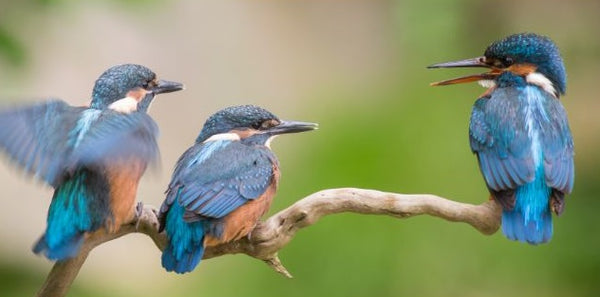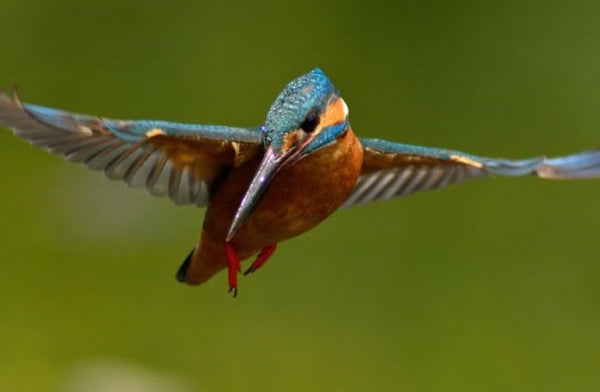Hey there, nature enthusiasts! Today, we're diving deep into the world of one of the most fascinating and colourful birds out there: the Kingfisher. I wrote this today as this is one of our most popular bird and I wanted to learn more about it.
So get ready for a journey filled with history, fun facts, and a touch of conservation concern.
A Glimpse into History:

The history of the Kingfisher is as rich and colourful as its plumage, woven into the fabric of human culture for centuries. Across continents and civilizations, this magnificent bird has left its mark in myths, legends, and folklore.
In ancient Egypt, the Kingfisher was revered as a symbol of protection and abundance, often depicted alongside the goddess Isis, who was believed to bring fertility and prosperity. Its vibrant colours were associated with the vivid hues of the Nile River, signifying life and renewal in the desert landscape.
Moving eastward, in Japan, the Kingfisher took on a more mystical significance. Known as the "Kawasemi," it was believed to possess magical powers, able to calm storms and bring good fortune to fishermen. Its image was often depicted in traditional Japanese art, symbolising tranquillity and harmony with nature.
In European folklore, the Kingfisher was linked to themes of love and fidelity. According to legend, it was said that if two lovers spotted a Kingfisher together, they would be blessed with eternal happiness. This belief persisted through the ages, immortalized in poetry and literature as a symbol of enduring romance.
But perhaps one of the most enduring tales comes from ancient Greece, where the Kingfisher was associated with the mythical figure of Alcyone. According to legend, Alcyone was transformed into a Kingfisher by the gods, forever bound to the sea in search of her lost love. The sight of a Kingfisher became a sign of hope and reunion, inspiring sailors and wanderers on their journeys across the waves.
Through the ebb and flow of history, the Kingfisher has remained a timeless symbol of beauty, grace, and the interconnectedness of all living things. Its legacy lives on in our collective imagination, reminding us of the wonder and mystery of the natural world.
Global Residents:
So, where can you spot these stunning creatures? Well, they're not exactly homebodies. Kingfishers are found in various countries across the world, from the lush forests of Asia to the wetlands of Africa, and even the serene riversides of Europe and North America. Talk about spreading their wings far and wide!
What Makes The Kingfisher Special:
Let's dive deeper into the fascinating world of Kingfishers and uncover what makes these birds truly remarkable:
1. Masterful Hunters:

Kingfishers are renowned for their exceptional hunting skills, especially when it comes to catching fish. With keen eyesight and lightning-fast reflexes, they can spot prey from above the water's surface and execute precision dives to snatch their meal. In fact, studies have shown that Kingfishers can accurately judge the position and depth of their prey, allowing them to calculate the perfect angle for a successful strike.
2. Adaptations for Aquatic Life:
Unlike many other bird species, Kingfishers have evolved specialised adaptations for their aquatic lifestyle. Their sleek, streamlined bodies and sharp, dagger-like bills are perfectly suited for diving and capturing fish underwater. Additionally, their waterproof feathers and transparent inner eyelids enable them to navigate and hunt beneath the surface with ease, making them true masters of their watery domain.
3. Social and Family Bonds:

Kingfishers are not just solitary hunters; they also form strong social and family bonds. We also have a lovely ornament where 2 kingfishers are being socialable on the same bit of driftwood. Many species of Kingfishers are known to mate for life, with pairs engaging in elaborate courtship rituals and cooperative breeding behaviors. They work together to excavate burrows for nesting and raising their chicks, sharing parental duties such as incubating eggs and feeding their young. This sense of partnership and cooperation contributes to the stability and success of Kingfisher populations worldwide.
4. A Symphony of Colors:
One of the most striking features of Kingfishers is their vibrant plumage, which dazzles the eye with a kaleidoscope of colors. From electric blues and fiery oranges to emerald greens and rich browns, each species boasts its own unique palette of hues. These dazzling colors not only serve as camouflage in their natural habitats but also play a vital role in courtship displays and communication among individuals.
5. Cultural Significance:
Throughout history, Kingfishers have held a special place in the hearts and minds of people around the world. From ancient myths and legends to modern-day art and literature, these birds have inspired awe and admiration across cultures and generations. In many societies, Kingfishers are revered as symbols of prosperity, protection, and good fortune, with their images adorning everything from sacred artifacts to everyday objects. Their cultural significance serves as a testament to the enduring impact of these magnificent birds on human society.
Migration and Climate Concerns:
Migration is a natural phenomenon observed in many bird species, including certain populations of Kingfishers. These migratory journeys can span thousands of miles and play a crucial role in their survival and breeding patterns.
One notable study conducted by researchers from the University of East Anglia and the British Trust for Ornithology revealed significant changes in the migratory patterns of Eurasian Kingfishers (Alcedo atthis) in response to climate change. The study, published in the journal Global Change Biology, analysed data from bird ringing programs and satellite tracking to track the movements of individual birds over time.
The findings indicated that rising temperatures and shifting weather patterns were influencing the timing and duration of migration for Eurasian Kingfishers. Warmer winters and earlier springs were prompting some individuals to alter their migration routes or extend their stay in certain areas, while others were adjusting their breeding and nesting behaviours to adapt to changing environmental conditions.
Furthermore, climate change is not just affecting migration patterns; it's also impacting the availability of prey species for Kingfishers. A study published in the journal Nature Climate Change, led by researchers from the University of Exeter, highlighted the potential consequences of warming temperatures on aquatic ecosystems and fish populations – a primary food source for many Kingfisher species.
According to the study, warmer waters and altered streamflow regimes could disrupt the abundance and distribution of fish species, making it more challenging for Kingfishers to find sufficient food during critical periods such as the breeding season. This could ultimately lead to declines in Kingfisher populations and threaten their long-term survival.
These findings underscore the urgent need for conservation efforts to mitigate the impacts of climate change on Kingfisher populations and their habitats. By reducing greenhouse gas emissions, preserving natural habitats, and implementing sustainable resource management practices, we can help safeguard the future of these magnificent birds for generations to come.

In conclusion, the Kingfisher is not just a bird; it's a symbol of nature's beauty and resilience! From its ancient roots to its modern-day struggles, it continues to captivate and inspire us. So, the next time you catch a glimpse of a Kingfisher darting through the air or diving into the water, take a moment to appreciate the wonder of this magnificent creature and the delicate balance of the world it inhabits.






















